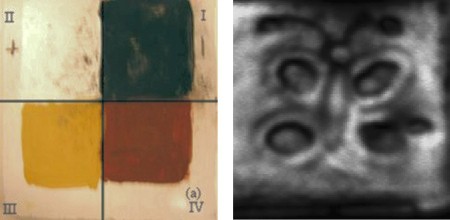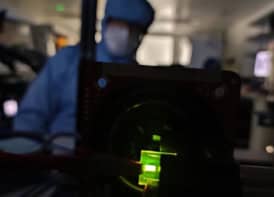
Spread over a 16 m-wide wall in the Palazzo Vecchio town hall in Florence, Leonardo da Vinci’s The Battle of Anghiari is a magnificent fresco depicting two horse riders in combat. Also impressive are la America Tropical by the Mexican muralist David Alfaro Siqueiros in the Italian Hall in Los Angeles, and the numerous frescos adorning the ancient Hagia Sophia church in Bulgaria. Unfortunately no one can see these paintings: they are all hidden beneath a layer of plaster.
If studies by a team of scientists from the US and France continue to prove successful, however, then it could be only a matter of time before such frescoes, which have often been covered for religious or political motives, are exposed. Although plaster is opaque to visible light, in the much lower frequency terahertz (1012 Hz) it all becomes clear. “Most non-polar, dielectric materials are transparent in the terahertz spectral range,” says Bianca Jackson, a physicist at Michigan University in the US. “Therefore, with enough power, terahertz can penetrate ‘infinitely’ thick, optically opaque materials such as concrete or wood.”
Jackson and her colleagues are collaborating with researchers from Picometrix — a photonics company based in Ann Arbor, Michigan — as well as the National Higher School of Advanced Techniques (ENSTA) and the Centre for Research and Restoration in the Louvre Museum, both in Paris. Their system involves scanning a pulse of terahertz light over a surface and then measuring how the amplitude of the reflected signal changes with time. Because materials have different dielectric properties, which determine how much light is reflected, these measurements can tell how dissimilar materials are layered on top of one another (Opt. Commun. 281 527). This makes it ideal for imaging frescos — a technique that won favour during the Renaissance in which pigments are painted into wet plaster.
No drawbacks
Although art historians regularly employ ultraviolet, infrared and Raman spectroscopy to examine the surfaces of murals, these techniques cannot probe deeper than a millimetre into plaster. On the other hand, X-rays and microwaves can penetrate many layers, but X-rays cannot distinguish between the layers and microwaves have a poor spatial resolution. Terahertz radiation has none of these drawbacks and, because it is non-ionizing, should not damage a painting either.
The Michigan team has already tested Picometrix’s “T-ray 4000” system on a graphite sketch of a butterfly imbedded in a 4 mm layer of plaster-of-Paris. After focusing the T-ray transceiver onto the back of the plaster, they found that they could make out the 2 mm wide graphite lines of the butterfly. The team is now planning to take the system next month to the St John the Baptist church in Vif, France, where there are believed to be many hidden frescoes.
Irl Duling, director of terahertz business development at Picometrix, says that the company is already shipping the T-ray system to customers. “T-ray 4000 is the only full-featured, portable time-domain terahertz system.”




